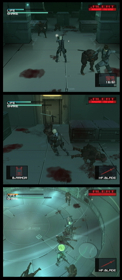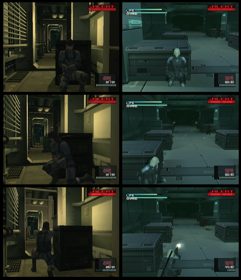Snake fostered the next step of Raiden’s awakening. He gave Raiden a sword—Raiden’s preferred weapon as a child soldier. Solidus later complimented Raiden’s swordplay: “I’ve been watching how you fight. It looks like you remember the way you used to kill in the old days.” Snake had never used swords; that way of fighting was Raiden’s alone.
The sword represented Raiden’s break from the Solid Map and a return to the player-actor relationship established during the Tanker Chapter. When Snake had brought the tranquilizer gun and later confiscated the pistol from Olga, the player had depended upon his actor’s character for his in-game options. Unlike any other weapons acquired during the Plant Chapter, Raiden received his sword through the narrative, and he knew how to use the sword through his character. The occasion cohered with MGS2’s formal pattern, too. The player had obtained a weapon from the narrative when Snake took Olga’s pistol, whereas the player obtained a weapon from the narrative when Olga gave Raiden her sword.

|
The subsequent gameplay sequence further asserted Raiden’s awakening. A large unit of specialized soldiers ambushed Snake and Raiden in a wide hangar. Once the two had reached the hangar’s far end, the exit wouldn’t open. Soldiers surrounded them, some of whom wielded swords that deflected gunfire. Raiden and Snake had to dispatch all before they could progress beyond the door and into a compact, circular arena where more enemies attacked.
The start of the hangar sequence formally resembled a boss fight during the Tanker Chapter. Soldiers had ambushed Solid Snake in a narrow hallway, and the player had used a crate for cover, occasionally popping out to shoot. The player needed to use those same tactics at the beginning of the hangar, but cover became sparer as he

|
progressed. The cover that remained became practically useless, and the subsequent circular arena lacked any cover at all. MGS2 gradually exposed Raiden to gunfire from all sides.
Both the level and enemy designs coerced the player into using Raiden’s sword rather than his guns. The player needed to press an awkward combination of buttons in order to move while shooting; Raiden’s aim worsened when he ran; and half of the hangar’s enemies deflected bullets with their swords. The sword, however, allowed Raiden more fluid movement. His blade deflected bullets when he had no cover, and its attack penetrated the sword-wielding soldiers’ defense. The player and Raiden both came to depend upon Raiden’s unique identity, and MGS2 finally began to reward them with a clear victory. The player could succeed in MGS2 only when he abandoned Solid Snake as an ideal.
Raiden had previously obeyed the Solid Map because circumstances had forced him to rely upon the player’s knowledge of
MGS1 in order to survive. Ever since MGS2’s climax in the torture room, though,
MGS2 had controlled the player. He could not completely control Raiden during the streaking blitz, and the hangar sequence forced him to respond to emergencies by relying upon Raiden’s
identity—fighting with the sword—in order to meet his Player Objectives. The player felt this reversal at its peak during the fight against twenty-five Metal Gear Rays, when Raiden surrendered despite the player’s desire to fight. The actor’s narrative will overrode the player’s desire to
act as the hero who wrecked Metal Gear.